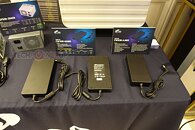- Joined
- Oct 9, 2007
- Messages
- 47,901 (7.37/day)
- Location
- Dublin, Ireland
| System Name | RBMK-1000 |
|---|---|
| Processor | AMD Ryzen 7 5700G |
| Motherboard | Gigabyte B550 AORUS Elite V2 |
| Cooling | DeepCool Gammax L240 V2 |
| Memory | 2x 16GB DDR4-3200 |
| Video Card(s) | Galax RTX 4070 Ti EX |
| Storage | Samsung 990 1TB |
| Display(s) | BenQ 1440p 60 Hz 27-inch |
| Case | Corsair Carbide 100R |
| Audio Device(s) | ASUS SupremeFX S1220A |
| Power Supply | Cooler Master MWE Gold 650W |
| Mouse | ASUS ROG Strix Impact |
| Keyboard | Gamdias Hermes E2 |
| Software | Windows 11 Pro |
Fortron's consumer brand, FSP, brought a handful new power products to CES 2020, besides its already launched CMT710 premium gaming chassis, the Hydro G Pro premium modular PSU from mid-2019, and Dagger Pro SFX PSUs. The inconspicuous-looking FSP500-30AKB looks like a cheap OEM-included PSU with rear 80 mm exhaust, which comes included with your case, and which you immediately discard. Only that it's possibly the most innovative thing FSP brought to CES. This PSU is being designed for Intel's upcoming PC spec that does away with the 5 V, 5 Vsb, and 3.3 V power domains altogether.
The pure-12 V PSU has only two domains: +12 V and +12 Vsb. What this means is a goodbye to the bulky 24-pin ATX power connector. The PSU only feeds 12 V to your motherboard, which uses onboard VRM and DC-to-DC switching to put out the lower voltage domains, including power for your SATA storage devices. The 24-pin connector is effectively reduced to a new 10-pin connector that only has 12 V and 12 Vsb cabling. Other cables include 8-pin EPS connectors for your CPU VRM, and 6+2 pin PCIe connectors for your graphics cards. EPS and PCIe power are purely 12 V-based standards already. The 5-pin connector is less than half as thick as your 24-pin connector, and 2 pins wider than an EPS connector. Some of the more premium PSUs may user thicker gauge wires for this connector.





Next up is the Emergy 1000, a UPS dressed like a travel bag, with wheels, handle, and a plastic body to boot, which is ready to hit the road. It also has a lid with a bag-like zipper, which opens up a compartment where you tuck in its 3-pin AC cable. Inside is a sealed lead acid battery (and not lithium-ion), and a 1.5 kVA pure sine-wave AC inverter. The charging component pulls 600 W off the wall to rapidly recharge the battery (most 1.5 kVA UPSes pull around 150 W). Besides taking in 3-pin AC (100-240 VAC wide input range), the Emergy 1000 also takes in 12 V DC from third-party solar panels. Unfortunately, FSP didn't put out any official Ah figures for the battery.
View at TechPowerUp Main Site
The pure-12 V PSU has only two domains: +12 V and +12 Vsb. What this means is a goodbye to the bulky 24-pin ATX power connector. The PSU only feeds 12 V to your motherboard, which uses onboard VRM and DC-to-DC switching to put out the lower voltage domains, including power for your SATA storage devices. The 24-pin connector is effectively reduced to a new 10-pin connector that only has 12 V and 12 Vsb cabling. Other cables include 8-pin EPS connectors for your CPU VRM, and 6+2 pin PCIe connectors for your graphics cards. EPS and PCIe power are purely 12 V-based standards already. The 5-pin connector is less than half as thick as your 24-pin connector, and 2 pins wider than an EPS connector. Some of the more premium PSUs may user thicker gauge wires for this connector.





Next up is the Emergy 1000, a UPS dressed like a travel bag, with wheels, handle, and a plastic body to boot, which is ready to hit the road. It also has a lid with a bag-like zipper, which opens up a compartment where you tuck in its 3-pin AC cable. Inside is a sealed lead acid battery (and not lithium-ion), and a 1.5 kVA pure sine-wave AC inverter. The charging component pulls 600 W off the wall to rapidly recharge the battery (most 1.5 kVA UPSes pull around 150 W). Besides taking in 3-pin AC (100-240 VAC wide input range), the Emergy 1000 also takes in 12 V DC from third-party solar panels. Unfortunately, FSP didn't put out any official Ah figures for the battery.
View at TechPowerUp Main Site






